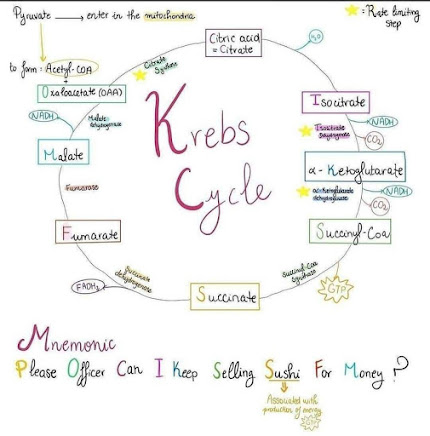Here is the trick for Krebs acid cycle. It often comes in Exams and you should learn it by this trick. This will help you to learn it quickly.
💚Trick💚
Angry Cow Is Angry Sing
Silly Funny Malody Out
Angry – Acetyl CoA
Cow – Citrate
Is – Isocitrate
Angry – a-Ketoglutarate
Sing – Succinyl CoA
Silly – Succinate
Funny – Fumarate
Malody – Malate
Silly Funny Malody Out
Angry – Acetyl CoA
Cow – Citrate
Is – Isocitrate
Angry – a-Ketoglutarate
Sing – Succinyl CoA
Silly – Succinate
Funny – Fumarate
Malody – Malate
Acetyl CoA:-
Acetyl-CoA is the precursor of fatty acid synthesis. Acetyl-CoA is structurally synthesized in different ways. For example, pyruvate is decarboxylated by pyruvate dehydrogenase in the mitochondria to form acetyl-CoA, which enters the Krebs cycle. Acid, acetyl-CoA is excreted from the respiratory tract.
Citrate:-
The citrate test is used to determine the ability of microorganisms to utilize sodium citrate, as nitrogen is the simplest source of carbon and inorganic ammonium hydrogen phosphate (NH4H2PO4). The enzyme-based system is called Citrate.
Isocitrate:-
Isocitrate dehydrogenase is an enzyme used withinside the third stage of the citric acid cycle. This organic response is an important process for producing molecules that are used to produce cellular energy. At this stage, it catalyzes the oxidative decarboxylation of isocitric acid. CO2 is released from isocitrate.
a-Ketoglutarate:-
Alpha-ketoglutarate, which determines the overall rate of citric acid circulation in the body. It is a nitrogen scavenger, a source of glutamate and glutamine, which can stimulate protein synthesis and inhibit protein breakdown in muscle groups. As the precursor of glutamate, glutamine is also a key metabolizing gas for cells in the gastrointestinal tract. AKG can reduce protein catabolism and growth protein synthesis, thereby improving bone formation in the skeletal muscle group. It can be used for medical applications.
Succinyl CoA:-
Mitochondrial succinate-CoA ligase (ADP) catalyzes the reversible conversion of succinate-CoA to succinate and coenzyme A and the conversion of ADP and salt to ATP. The enzyme is a heterodimer containing SUCLG1 and SUCLA2 monomers. A heterodimer that appears as an isoform.
Succinate:-
Succinate or carboxylic acid is related to many chemical processes in the human body. In dietary supplements, it can be used for menopausal symptoms such as hot flashes and irritability. Succinate can also be used for skin with arthritis and joint pain.
Fumarate:-
Iron fumarate can be a form of iron. Iron usually comes from the food you eat. Iron is converted into haemoglobin (HEEM or globulin) and part of haemoglobin (MY or globulin) in the body. Haemoglobin carries the 8th atom through your body. The blood reaches the tissues and organs. Haemoglobin helps muscle cells store oxygen. Iron fumarate is used to treat iron deficiency anaemia (aLack of red blood cells due to lack of iron in the body).
Malate:-
Chromium malate, a new form of natural chromium(III) complicated that has been synthesized withinside the Liuqing Yang and Xiangyang Wu laboratory.
Kerbs cycle:-
More TRENDING🔥🔥🔥 Biology Trick…
Click 👉 » BIOLOGY TRICKS «
Chromium malate, a new form of natural chromium(III) complicated that has been synthesized withinside the Liuqing Yang and Xiangyang Wu laboratory.
Kerbs cycle:-
More TRENDING🔥🔥🔥 Biology Trick…
Click 👉 » BIOLOGY TRICKS «

